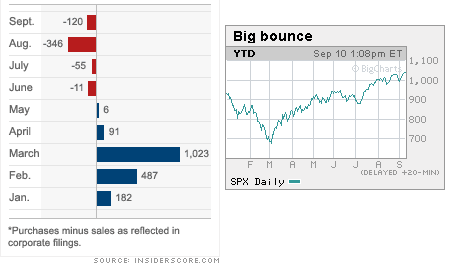If you’re a corporate “insider” such as an officer, director, or other certain employees, your purchases and sales of stock must be reported to the SEC in order to reduce illegal insider trading. Technically, an insider is not supposed to trade if they have “material nonpublic information” when making the purchase or sale. But still, who would know better?
Therefore, it’s interesting to see how insider trading activity as a whole by comparing the amount of shares being bought and sold during all this volatility, and then compare that with the market. See the graph below compiled in this CNN Money article:

Insiders loaded up overall during the panicky months of February and March, and then seemed to sell off a bit in happy August. I wouldn’t necessarily base future trades on this relationship, but it is definitely food for thought!
 The Best Credit Card Bonus Offers – 2025
The Best Credit Card Bonus Offers – 2025 Big List of Free Stocks from Brokerage Apps
Big List of Free Stocks from Brokerage Apps Best Interest Rates on Cash - 2025
Best Interest Rates on Cash - 2025 Free Credit Scores x 3 + Free Credit Monitoring
Free Credit Scores x 3 + Free Credit Monitoring Best No Fee 0% APR Balance Transfer Offers
Best No Fee 0% APR Balance Transfer Offers Little-Known Cellular Data Plans That Can Save Big Money
Little-Known Cellular Data Plans That Can Save Big Money How To Haggle Your Cable or Direct TV Bill
How To Haggle Your Cable or Direct TV Bill Big List of Free Consumer Data Reports (Credit, Rent, Work)
Big List of Free Consumer Data Reports (Credit, Rent, Work)
I wonder if similar data can be found if well known investors loaded up as well during panicky months?
I loaded up during panicky months. It just makes sense to me.
That makes sense….best investors are contrarians. The recession is usually over, or pulling out, when everyone finally thinks we’re in one. The best time to invest is when the general public is afraid to. These people are in it for the long haul.